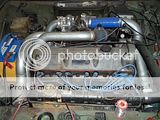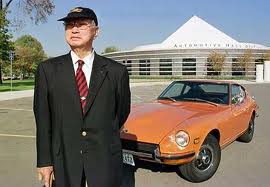Nothing directly for Datsun, but the Wolseley 24/80 is British Motor Corporation (Australia) car from 1962 to 1965, and a wheelbase an inch longer than the Austin Freeway, Wolseley 15/60, Wolseley 16/60. It was powered by a six-cylinder version of the 1622 cc B series engine, known as the "Blue Streak" straight-6 with a capacity of 2433 cc. It's just a Bseries 1622 cc engine with two more cylinders, while the BMC C-Series was a straight-6 automobile engine produced from 1956 to 1971. The B series six only lasted from 1962 to 1965
Unlike the Austin designed B-series engine, the C series came from the Morris engines drawing office in Coventry. Displacement were the 2,639 cc 77x89 mm
(1954-1959 Wolseley 6/90,1954-1959 Austin Westminster A90/A95/A105,1955-1958 Morris Isis,1958-1959 Riley Two-Point-Six,1956-1959 Austin-Healey 100-6), the 2,912 cc, 83.36x88.9 mm. Four bearing crankshaft.(1959-1968 Austin Westminster A99/A110, 1959-1968 Wolseley 6/99 and 6/110, 1959-1964 Vanden Plas Princess 3-Litre, 1959-1967 Austin-Healey 3000) and the 2,912 cc, 83.36x88.9 mm. Seven bearing crankshaft. (1967-1971 Austin 3-Litre ,1968-1970 MGC)
The Austin A55 Cambridge, Austin A60 Cambridge, MG Magnette Mk. III, Morris Oxford V, Riley 4/68 and Di Tella 1500 was the same base as the Wolseley 24/80, with the inch shorter wheelbase, and 1489 or 1622 four cylinder engines.
The 1622cc and 1798 cc was a pretty common early B-series fitment till 1969, then we went to the poorly executed, but basically sound 1485 and 1748 cc OHC E4 from the Maxi and Nomad 1968 to 1975. The early 210 and 410 Datsun Bluebirds in Australia ran an A or B series cast off.
Austin/Morris/Leyland I6's from Australia
Austin was number one selling before Holden took over when they could finally make enough of The Right Honorable Ben Chifley's 132.5 cubic inch 48 215 FX Holdens. The Holden engine had 3.75" bore spacing's like the early British Vauxhall Velox engines, with four bearing cranks and some parts of the water cooling system as near as dammit interchangeable. So the 1948 to 1966 Vaxhall I4 till the 1967 OHC and 1156/1256 cc Opel era and Velox I6's to 1961 had very similar blocks Holden's six port 132.5 and 138 Grey motors
The Morris Isis, Oxford and Major were pretty good old humps to cruise around Australia in. They were locally assembled with a high proportion of B series and C series engine parts. Then the Alec Issigonis era pushed for the Morris Mini and 1100/1300 and the 1800 and Maxi based engineering "deep sixed" the old rear drive cars by 1965. The front drive worked for the Bathurst winning Mini and they liked but not very strong 1100/1300, but not the E-series engined Morris 1300/1500/Nomad.
The borderline successful 120 inch wheelbase 1800 wasn't powerful enough, and the local engineers weren't able to get British backing to get a power steered Rover 3500 engine hooked up to the Borg Warner 35 transverse front drive gearbox. So the 1800 and Freeway lost market share yearly.
Later, the final Front drive push was the locally made version of the Pommy Austin Maxi based E series five bearing Four and seven bearing six in two sizes. It was made as a B series 4 cylinder replacement engine, creating the Tasmin and 2227 and 2622 cc Kimbery. The Morris Marina even got this engine in 2622 cc form, making the 17 second quarter-mile 3 door hatch Marinas scare the undies off Leyland Marina buyers who were able to tick the right options. The Leyalnd P76 had early Spencer King SD1 unibody body engineering with similar IFS and steering, but was a failure commercially, and the P82 with its 3.3 V6 version of the Leyland 268 cube version of the Buick Olds Pontiac Rover based 215 never saw the light of day.
The E6 had some major issues, but its technically interesting and able to take the loads, which is why modern E4 versions, the chain cam R series and belt cam S series version of it was used in the Ferrari carbed twin Weber DCNF MG Maestro in 1983 to the early 1984, although the 1598 cc single throttle version lasted till 1995
http://www.shannons.com.au/club/enthusi ... bo/photos/
http://www.aronline.co.uk/blogs/facts-a ... -s-series/



 Prince/240K/Skyline/Holden VL sixes in Australia
Prince/240K/Skyline/Holden VL sixes in Australia
After the Datsun 210 took Agent K's team to 1st and 4th class wins in the 1958 MobilGas Round Australia trial race in 1958, the Japanese realized that the first export market to crack was Australia!
http://on.aol.com/video/nissan-datsun-2 ... -517236538
It was that renegade Christian's crazy penchant for understanding markets which made the 510, 240Z and Box Skyline what they were, and they became icons to the soul of Nissan.
http://www.zonc.org/katayama.html
http://en.wikipedia.org/wiki/Yutaka_Katayama
And at 104 years old, he still alive, and the reason for Nissan's survival, despite being about as popular as a Pork Pie at a Yiddish wedding inside Nissan itself. And that is typical of the unsung endeavors of these early Japanese Engineers, they were looked at as traitors as they had imbibed the spirituality and soul of the west, yet made it a Japanese institution. He will live on eternally as the "thousand word" picture man, who could sell 40 thousand 510's in its inaugural year by just music and a few images on a Television commercial.
As a kid, we had heaps of those old rear drive ohv Princes around. They ran hard despite there totally pedestrian looks. The Prince engines were not that amazing, but with Nissan's acquisition of the financially floundering but technically rich Prince company in 1966, it was genesis that gave the Nissan Cedric and Skyline and S20 four valve per cylinder Fairlady the most technically advanced engineering. You could see where it all started when the 5 speed ZF gearbox, Banjo axled, Limited slip diffed, 26 US gallon fuel tanked, triple Weber carbed I6 OHV Princes had good Aussie sales, although they were a bit 'weird' with Rover P6 style engineering and consequently, P6 style costs. Under Nissan, the Japanese perpetuated the NEC idea that its very bad for business to be sublet, wound up, and ultimately lost, but that business must be eternal. They raced well at Philip Island and Bathurst, and the typically random 'Japanesy' recirculating ball steering couldn't hide the sharpness of the chassis, carburation, and engineering. The Hakosuka spirit was right there in 1964, and by 1992, it took out Australian Group A motor racing by taking the Bathurst Mountain in the James Hardie 1000 with 400 pounds of pig iron handicap unable to stop its success. The Nissan Skyline GTR is what Holdens XU1 GTR should have become.
http://www.classiccar.co.nz/articles/19 ... ance-06-yb
The Aussie Princes are around, but not in big numbers. The Prince design team lead the fight to great caburattion and typcially great production engineering. They dragged Datsun engines away from direct copies of BMC A and B series, to become much better A10, 11,12,13, 14 and 15 engines of the commercially successful sedans and pickups and even the front drive Cherry and 1500 4x4. The Nissan Bluebird hybridized Mercedeas six and BMW Four cylinder engieering into Kent Ford bore spacings on the L series OHC fours, and in the Cedric and Gloria by Nissan, made wider bore spacing L OHC in the sixes with the same conrod stamping, bearing and cam gear parts. The Japanese were working the tooling with Shogun sword perfection, each engine optimized without a desire to make the 4 and 6 cylinder L series OHC engines cookie cutters on the cheap.
The L24 was imported in the locally imported Datsun 240K, imported in the locally sold Skylines from 1981 to 1984 and then in RB30 form, imported as the Holden Commodore VL and locally made Nissan Skyline from 1985 to 1992. The New Zealand market Holdens got RB20's










 .
. 